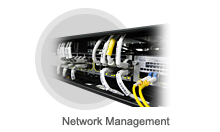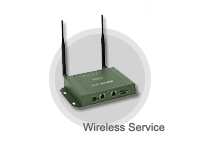Network Services
Web service is Computer and Information Network Center central focus and concern. Here, in brief, is what we do.
1. Network Infrastructure and Service With the rapid development of the Internet, the demand for bandwidth in the campus network has been increasing dramatically. In September 2013, CINC upgraded the campus fiber optic backbone to 10G Ethernet (10 Gigabit Ethernet). Along with the existing 1G Ethernet core switching routers, the upgraded backbone has successfully connected different buildings by fiber optic cable, and formed a fault-tolerant dual-routing infrastructure. The campus network extends as a star-shaped polygon structure, primarily divided into five sections: Backbone Network, Business School Network, Management School Network, Engineering School Network, and Dormitory Network. The networks of each academic faculty, connected to the campus network backbone via a 10G Ethernet interface, provide teachers and students with rapid Internet access to information with data, audio, video, and graphics all together.
With the rapid development of the Internet, the demand for bandwidth in the campus network has been increasing dramatically. In September 2013, CINC upgraded the campus fiber optic backbone to 10G Ethernet (10 Gigabit Ethernet). Along with the existing 1G Ethernet core switching routers, the upgraded backbone has successfully connected different buildings by fiber optic cable, and formed a fault-tolerant dual-routing infrastructure. The campus network extends as a star-shaped polygon structure, primarily divided into five sections: Backbone Network, Business School Network, Management School Network, Engineering School Network, and Dormitory Network. The networks of each academic faculty, connected to the campus network backbone via a 10G Ethernet interface, provide teachers and students with rapid Internet access to information with data, audio, video, and graphics all together.
To provide boarding students with the best quality network in their dormitories, CINC upgraded the dormitory network to 60M/15M in September 2011. A number of students are now employed by the Internet service providers, staying available in each dormitory to deal with Internet-related problems at a moment’s notice.
In response to the increase of Internet users, CINC has been upgrading, since January 2012, the backbone network of different buildings to high-speed Gigabit Ethernet routing switches, and dividing the network into smaller segments so as to reduce the increasing number of network threats. Moreover, with the aid of some related automation system, this has made it much easier for users to apply for any network service.
Following the trend of the e-generation, CINC provides not only servers for WWW, email, and domain name system but also a non-synchronous network system for teaching, offering students a learning environment that is better, richer, and more flexible. Moreover, CINC has established an interactive video conference system for important events such as opening ceremony, freshmen orientation, and graduation ceremony.
 With the rapid development of the Internet, the demand for bandwidth in the campus network has been increasing dramatically. In September 2013, CINC upgraded the campus fiber optic backbone to 10G Ethernet (10 Gigabit Ethernet). Along with the existing 1G Ethernet core switching routers, the upgraded backbone has successfully connected different buildings by fiber optic cable, and formed a fault-tolerant dual-routing infrastructure. The campus network extends as a star-shaped polygon structure, primarily divided into five sections: Backbone Network, Business School Network, Management School Network, Engineering School Network, and Dormitory Network. The networks of each academic faculty, connected to the campus network backbone via a 10G Ethernet interface, provide teachers and students with rapid Internet access to information with data, audio, video, and graphics all together.
With the rapid development of the Internet, the demand for bandwidth in the campus network has been increasing dramatically. In September 2013, CINC upgraded the campus fiber optic backbone to 10G Ethernet (10 Gigabit Ethernet). Along with the existing 1G Ethernet core switching routers, the upgraded backbone has successfully connected different buildings by fiber optic cable, and formed a fault-tolerant dual-routing infrastructure. The campus network extends as a star-shaped polygon structure, primarily divided into five sections: Backbone Network, Business School Network, Management School Network, Engineering School Network, and Dormitory Network. The networks of each academic faculty, connected to the campus network backbone via a 10G Ethernet interface, provide teachers and students with rapid Internet access to information with data, audio, video, and graphics all together.To provide boarding students with the best quality network in their dormitories, CINC upgraded the dormitory network to 60M/15M in September 2011. A number of students are now employed by the Internet service providers, staying available in each dormitory to deal with Internet-related problems at a moment’s notice.
In response to the increase of Internet users, CINC has been upgrading, since January 2012, the backbone network of different buildings to high-speed Gigabit Ethernet routing switches, and dividing the network into smaller segments so as to reduce the increasing number of network threats. Moreover, with the aid of some related automation system, this has made it much easier for users to apply for any network service.
Following the trend of the e-generation, CINC provides not only servers for WWW, email, and domain name system but also a non-synchronous network system for teaching, offering students a learning environment that is better, richer, and more flexible. Moreover, CINC has established an interactive video conference system for important events such as opening ceremony, freshmen orientation, and graduation ceremony.
2. External Connections

External connections are primarily based on the Tainan local network of the Taiwan Academic Network, powered by a 1 Gigabit Ethernet high-speed Internet connection. To accelerate network access to international sites and facilitate international access to the STUST website, external connections are further bolstered by 22 FTTB cables connected to HiNet--3 x 100M/10M and 19 x 10M/2M—and by NCTU International Networks (50M guaranteed Bandwidth).CINC provides teachers and students with SSL VPN services, which allow them free access first to the campus network and then to the Taiwan Academic Network and international academic networks.
3. Online Teaching 

To create a learning environment with the campus network, STUST launched the My Digital Learning platform in 2011. The platform uses a personalized platform, where individual students log in to see a broad range of information and material related to the courses they take, including announcements, course materials, forums, etc. Teachers and students can use a variety of functions on the platform to communicate and discuss with each other. Teachers are able to upload handouts or course materials onto the platform, while students are allowed to regularly check if teachers have posted any new course information or download any course material for a review. Teachers may also use the platform to create tests to see how much students have learned in class.
4. Wireless Network

CINC set up the Campus Wireless Network to provide teachers and students easy access to data and information on the Internet via laptops or smart phones on campus. CINC constructed the wireless network environment in three parts: (1) the library and the activity center, (2) conference rooms and public spaces in all buildings, (3) outdoor spaces in the campus. All three parts have been completed, providing full coverage for all academic and administrative buildings and their surroundings.









